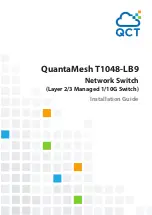
The 1930 PoE Class 4 switches support the IEEE 802.3at standard, which allows IP telephones, wireless
LAN Access Points, and other appliances to receive power as well as data over existing LAN cabling. For
further information regarding PoE power, see the Hewlett Packard Enterprise Web site at http://
www.hpe.com/networking/ResourceFinder.
• SFP slots for fiber or copper uplinks:
Using Aruba SFPs, these products support optional network connectivity with the following speeds and
technologies:
NOTE: Transceivers not on the 1930 approved list are used at your own risk and may void
support and warranty.
Transceiver Form-
Factor and Connector
Speed
Technology
Cabling
SFP Connector
1 Gbps
1000-T
Copper (twisted-pair)
RJ-45
1000-SX
Fiber (multimode)
LC
1000-LX
Fiber (multimode or
single mode)
LC
10 Gbps
10000-SR
Fiber (multimode OM3/
OM4)
LC
10000-LR
Fiber (single mode)
LC
10000-CR
Copper (fixed)
Direct Attach
NOTE: SFP+ only supported on JL682A. JL683A, JL684A, JL685A, JL686A
PoE Power
1930 switch series PoE power delivery
Power Over Ethernet (PoE) functionality is supported on certain 1930 models, known as power source
equipment (PSE) ports which provide power to connected devices. The devices receiving power through PoE
are referred to as powered devices (PDs). The switch automatically detects the presence of a PD on a PSE
port, and the switch uses physical layer classification to assign initial power to the PD. After the PD has
powered up, the switch can refine the assigned power using LLDP communication messages from the PD.
The PoE software supports two power modes to allocate power by Usage (default) or Class. The default
Usage mode reclaims unused power for use by new PD connections or increased power demand by existing
powered PDs. The configurable Class mode reserves the full PD requested class power from the total
available power budget. Ports are assigned one of three configurable PoE priority values (Critical, High, and
Low). When more power is requested than is available on the switch, the switch provides power to high
priority ports before lower priority ports.
Chapter 2 Overview
11












































